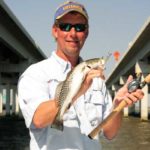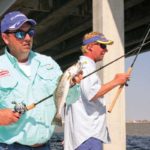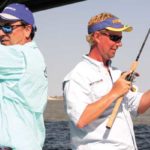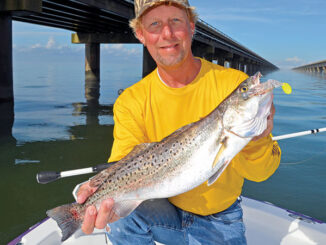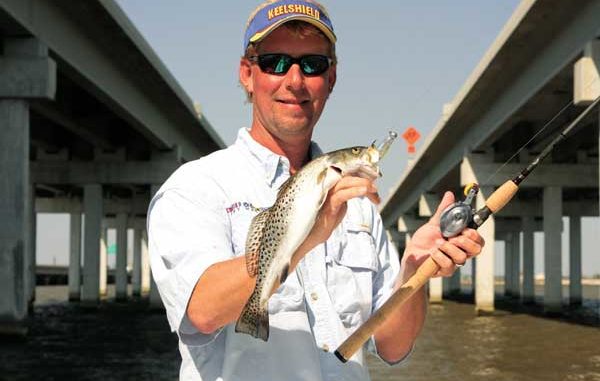
Do you have trouble catching fish at the bridges in Lake Pontchartrain? It’s probably because you’re not using this technique.
Capt. Greg Schlumbrecht believes that the old 80/20 rule is no more evident anywhere else in the world than it is at Lake Pontchartrain during May. His theory is that 80 percent of the anglers catch 20 percent of the fish, while 20 percent of the anglers catch 80 percent of the fish.
I had the opportunity recently to join Schlumbrecht, a certified member of the 20-percent club, and Capt. Tommy Pellegrin, a renowned Louisiana offshore guide who immediately fell into the 80-percent club, as this was his first time fishing Lake Pontchartrain.
We left The Dock at Slidell, and headed directly to the train trestle where Schlumbrecht typically sees legions of boats lined up to fish the pilings under the popular railroad span. His mission was to teach Pellegrin how to do the Pontchartrain Pop.
I already knew about the Pontchartrain Pop, although I am no master of it. Like Yoda’s efforts at teaching a brash Luke Skywalker about the force, most of Schlumbrecht’s instruction fell on deaf ears. Even the demonstrations of his fishing powers did little to make me listen.
The simple fact of the matter is that anybody who wants to consistently catch speckled trout at Lake Pontchartrain must master the Pontchartrain Pop. Perhaps watching Schlumbrecht teach Pellegrin would rub off on me more than it did during my time as student.
Pellegrin was already casting his opening night Deadly Dudley Bay Chovey under the bridge and between the pilings before Schlumbrecht could drop his trolling motor in the uncharacteristically muddy water. Out the corner of his eye, Schlumbrecht saw and started teaching.
“You may catch some fish up in there, but there’s a lot of trash, and you’ll stay hung up a lot,” he playfully scolded. “Stick with the pilings, and try pitching your bait as close as you can rather than cast overhand. It’s just like pitching a jig to a cypress tree when you’re bass fishing. Grab your bait in one hand and swing it out while lifting your rod.”
Pellegrin started fishing as instructed, but Schlumbrecht explained that as long as he was fishing like he was, he would be extremely lucky to feel a bite. Pontchartrain trout are known for being light biters that transmit just the slightest of ticks — if they even send any kind of tick at all.
These trout are also known for what Schlumbrecht called “sitting on it.” This is what happens when trout at the bases of the pilings eat your bait and don’t move an inch. Pontchartrain trout are more like bass in that they sometimes eat what passes in front of them without flipping a single fin.
“You’ve got to stay in constant contact with your bait as it’s falling,” Schlumbrecht continued. “Try this. As soon as our bait hits the water, let some line off your reel by pulling your rod all the way back to the 3:00 position behind your back. Engage your reel and drop your rod tip back down to about 10:00 just fast enough to stay in contact with your bait as it falls straight to the base of that pole.”
As a bait falls next to a piling like this, it is extremely important to feel for anything out of the ordinary. Anything that feels different than the pitch before might indicate a fish, but it’s amazing how quickly we can justify not setting the hook because it was nothing more than a piece of trash, a rock on bottom or maybe our bait just bumped the piling.
“When in doubt, knock ‘em out,” Schlumbrecht preached. “If your bait does anything different than the cast before — even the pop before — odds are it’s a fish.”
After quickly fishing several pilings without a bite, Schlumbrecht suggested that Pellegrin and I start working our baits a little differently. He noticed that, while I had been following my bait back to the bottom each time with my rod, I had been lifting it off the bottom rather than popping it.
“Pop the bait off the bottom rather than lifting it,” he instructed. “You want your bait to jump up off the bottom fast enough and erratically enough to get some attention. What I like to do if a trout doesn’t hit me on the initial drop is pop it up about 2 or 3 inches off the bottom. Then I start getting more and more aggressive every pop after the first one to the point that I actually pop it twice moving from 9:00 to 12:00 with my rod.”
With each pop, Schlumbrecht doesn’t concern himself with moving the bait forward at all. Since he casts into the tidal current and retrieves his jigs with that current, he simply allows the current to grab his bait and move it however it might. This gives his jigs an enticingly erratic action that trout have a hard time resisting.
The most important part of the Pontchartrain Pop at this point is to not throw slack in your line by immediately lowering your rod tip back toward the water. Rather, keep your rod tip at its highest point at the end of each pop to keep your line taut.
“The only way you’re going to feel most of these bites is if your line stays taut the entire time your bait is in the water,” Schlumbrecht said. “Bites come while the bait is falling most of the time, so you want to lower your rod tip at the same speed that your bait is falling. Constant bait contact is key.”
Mastering these steps will put you well on your way to perfecting the Pontchartrain Pop, but it is what you do when you realize a trout is sitting on your bait that can push you up to Yoda status.
Very often, Schlumbrecht says that when he starts to make his next pop his bait doesn’t budge at all. There is no tap. There is no bump. There is no nibble. Rather, there is dead weight as if his jig had fallen between two rocks or hung on a piece of debris.
“When you feel that, you can bet a trout is sitting on it,” he said. “When I feel that heavy sensation, all I do is vigorously continue my pop all the way back to the 3:00 position in one single motion. It almost looks as if I’m about to fall over backward. You’ve got to do something to try to set the hook, and this is about the best I’ve found to do it.”
But, alas, no matter how much we practiced the Pontchartrain Pop on this day, the trout just weren’t on the bridges to reinforce that Pellegrin and I were doing it correctly. It was a little early in the year, and the firm grip of winter had yet to let go even though the calendar said it was spring.
Schlumbrecht suggested we go try some dead-end canals because it didn’t matter where we fished since the same popping retrieve would work just about anywhere in the Pontchartrain Basin.
It wasn’t long before Pellegrin saw first hand the importance of maintaining constant contact with his bait. As he was following his lure back to the bottom with his rod, he detected something that felt out of the ordinary. He set the hook and was rewarded with his first-ever Lake Pontchartrain speckled trout.
“Dang, that was a subtle bite,” he said. “And it didn’t last but a fraction of a second. Good thing I was following my bait with my rod because I never would have felt that fish otherwise. I would imagine it pays to be a line-watcher out here. Do you ever see bites that you don’t feel?”
“I’m just not a line-watcher,” Schlumbrecht answered. “I know a lot of guys out here like to use visible line like the Berkley Vanish Transition or the Stren stuff that you can really see. For me it’s all about feel.”
Schlumbrecht went on to say that as a charter captain, he’s constantly watching what’s ahead to put his customers in the best possible position to catch fish. Because of that, he’s perfected fishing with his rod off to the side of his body rather than right up against it and with it perfectly balanced in his hand.
“I want to feel every single move the tail of that Bay Chovey makes,” he said. “In all the time I’ve been fishing the lake, I’ve probably seen only about 15 strikes by watching the line. But with the way I hold my rod and the gear I use, I can just about tell you if a trout so much as breathes on my bait.”
As someone who is used to pulling in snapper, wahoo and grouper, Pellegrin wrapped up our trip by explaining that the Pontchartrain trout bite is not horribly different than bites you get at other places in Louisiana, but it is different enough to fool anglers who aren’t prepared for its subtleties.
“I think I learned the Pontchartrain Pop today,” Pellegrin said. “For me, it looks like a big key is having good, sensitive equipment and low-stretch line. Anything that’s going to help you feel the bite better is to your advantage.
“Whether it’s a small thump, your bait stops short of the bottom or it’s just heavy, you’ve got to be able to feel that to know to set the hook. I think the Pontchartrain Pop is a great way of feeling the bite that is made even better with good equipment.”
Pellegrin is well on his way to moving from the 80-percent club to the 20-percent club. Now if I could only get Schlumbrecht to take me out again to show me one more time what I’m doing wrong.
I may never learn.
Contact Capt. Greg Schlumbrecht at 985-960-1709.
